Note: This blog is long and autobiographical. I highlight the key points to give you convenience if you are in a rush.
Before sharing how I contributed to the learning of others, I’d like to explain what a personal learning network (PLN) is. You can get a sense of PLN after watching this video:
Just as the quotation at the beginning, PLN is a two-way process; I am an information taker and an information exporter. If one way is cut off, PLN will lose its significance. When I debriefed my learning in my last blog, “Summary of personal learning,” I am an information taker because I learn from others. This blog will talk about how I export my learning to help others.
————————————————————————-
 The primary platform is Twitter. I use hashtags to categorize my learning and make my learning easy to be found by others. The hashtags I used this semester include #InclusiveEd, #edtc, #LearningProject, #TeachingPhilosophyCollection, #TeachingMaterial, #PhysicalLayout,#CodingForKids, etc.
The primary platform is Twitter. I use hashtags to categorize my learning and make my learning easy to be found by others. The hashtags I used this semester include #InclusiveEd, #edtc, #LearningProject, #TeachingPhilosophyCollection, #TeachingMaterial, #PhysicalLayout,#CodingForKids, etc.
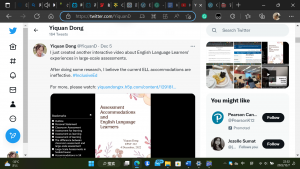
#InclusiveEd
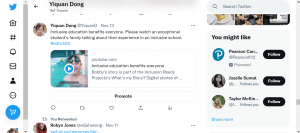
#edtc300
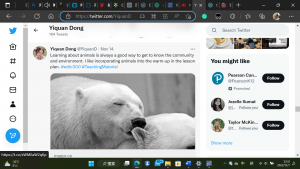
#TeachingMaterial
Hashtags enable us to learn from people worldwide as long as they use Twitter and type certain hashtags in the search box. My frequent use of hashtags gains some followers who are not my classmates and are total strangers to me.

My followers who are not in this class
This is the charming point of the hashtag. It is like a key to a room where many people share the same interest and do not judge me because I am a beginner in my educational career.

Hashtags are like keys to “The Room of requirement.” Photo by @olqa29112003 via Pinterest
Yeah, we look for interest instead of backgrounds. I don’t need to know the person in my PLN personally; Our contribution to that same learning focus is what brings us together.
I use the comment to expand others’ learning. For
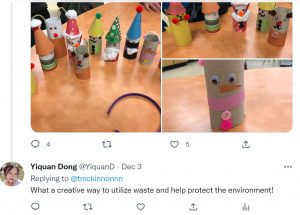
Turn waste into handcrafts
example, in this post, I connect her handcraft to teaching.
In this post, I advocated using puppets to engage students.
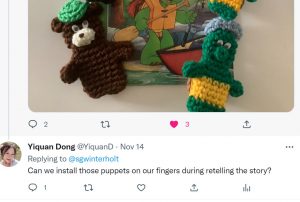
Use puppet to engage students to narrate stories.
As my major is English, I always want to break the boundaries of reading material, which is restricted to canons and print texts. Why not use online articles, posters, and/or short videos to learn and externalize students’ learning? Therefore, I comment on my peers’ posts to inspire them to see the educational value of their shared resources.
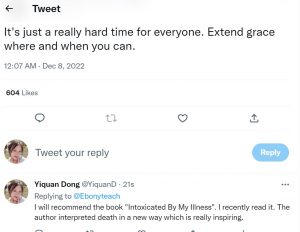
I exported my learning to help people see the bright side of life.
I post valuable materials, and people retweet them based on their interests. I would like to matapher this process as buffet; People choose what they like. I not only share resources but also attach reflections and comments beside them. I believe this will make it easier for people to make a match between their appetites (needs) and food (my sharing resources).
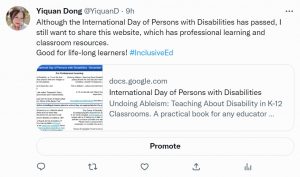
I share and generate main ideas

I share and discuss the possibility of implementing authentic writing in future classrooms.

I am a reviewer who aims to export valuable resources to my audiences.
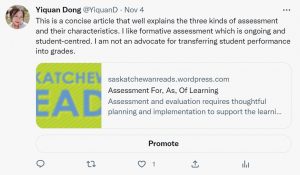
I will reflect on my opinions while assessing the resources.
I direct message verified Twitter accounts to show my interest and further explore my learning. It is known that most verified accounts are owned by celebrities. Although I mentioned that PLN only values interests and contributions, I still feel timid to click that small envelope. What if they think I am a crazy fan or ignore my message? To my surprise, some of them respond and act like real people- they are friendly. Direct messages help me get first-hand information from professionals and keep my theory learning pace with those on the cutting edge of that field.
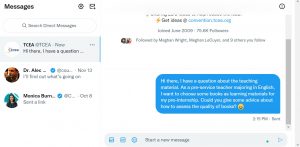
I asked for the methods of assessing the quality of children’s and adolescent books.

Some verified accounts seem to turn off the direct message function. But at least I tried.
—————————————————————–
If I say Twitter is a worldwide PLN (or universal learning network?), then Edusites, Discord, and Zoom are classroom-based PLNs.
I contribute to others learning by leaving comments under their weekly blogs. My comments serve as a summary (like sticky notes on the edge of files) instead of bringing something new. I wish this could help the post owner navigate their blogs for future use. Moreover, commenting on others’ blog is actually a learning process for me. The first thing I learned is digital etiquette. One key question for assessing digital etiquette is, “What is considered polite and appropriate behavior in regards to communicating with others online?” Edusites and personal websites should be safe individual territories. When I comment, my first concern is language use. What kind of language can show my interest appropriately? You could see an improvement in my commenting skills.
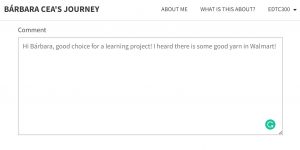
I will offer extra resources for people to enhance their learning projects.
In the beginning, my comment focused on complements (敷衍评价内容). If you browse the following comments, you will find they are longer and focused more on the content.
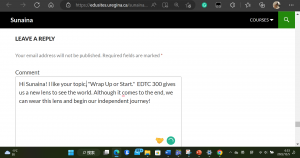
You can see I always begin my comment with a greeting.
The second thing I learned is the fact that every small hobby is worth to be kept. This learning largely comes from people’s learning projects. For example, Jozelle is nurturing the hobby of spinning pens this semester. In the past, I would doubt if this counted as a hobby. However, when I saw her weekly-updated learning projects, I realized that everything could be deeply explored. Furthermore, it inspires me that I should respect every student’s interests.
————————————————————————-
 To be honest, I didn’t help others a lot on Discord, which is a social platform designed mainly for gamers. On this platform, our class mainly discussed technical issues they met on other media.
To be honest, I didn’t help others a lot on Discord, which is a social platform designed mainly for gamers. On this platform, our class mainly discussed technical issues they met on other media.

I find partners for teamwork after class on Discord.
It is a place for collective thinking and off-class networking. As I remember that Katia said we could earn points by helping others on Discord, I racked my brain with the intention to solve others’ technical difficulties. Although I tried, I still had no good idea in the end.
However, I still tried my best to respond to others and kept the communication going on.
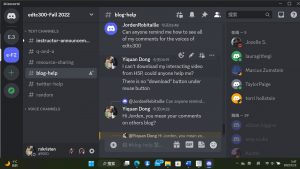
I will continue the question if I don’t know it, so this question will not sink.
I did this because I know how disappointing it will be if a question sinks because of collective neglect.
I am the one who asks many questions on Discord. I believe my questions contribute to others learning because they may have the same questions. Look at the screenshot of my question!

Question 1: How to use “gallery” and “aside” in WordPress?
It is nice that I do not feel embarrassed when I post my questions; sometimes I feel asking questions is another way to tell people I am so silly. This online community is welcoming and inclusive. We are of different ages and master different levels of technical skills. I felt grateful when people helped me.
The biggest technical problem I had this semester was the sudden shutdown of Edusites. I was in a great panic then and expressed my concern on Discord.
It turned out that many people encountered the same problem. I went to Twitter to direct message Dr. Couros with a wish that he could offer solutions quickly. And my wish came true! I categorize this conversation as a contribution and proof of my networking skills because I reported a big question, enthusiastically found resources to solve it for the benefit of all, and kept it on track by updating the solution on Discord.
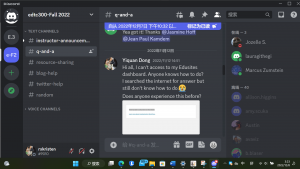
Report issue. EDTC300 community was my first place to go when I had technical issues
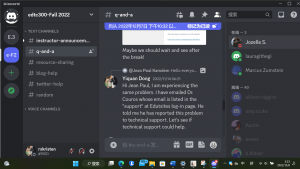
Gather information by listening to others problems

Report issue via Twitter for quicker response
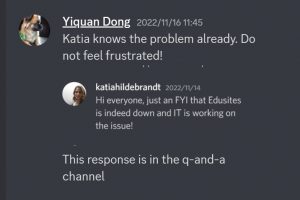
I kept everyone on the same page.
————————————————————————-
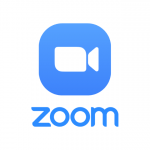
Compared with the above PLN platforms, Zoom looks more traditional and academic. For introverted people like me, we benefit a lot from Zoom Chat. Katia encourages us to use the text, an alternative to voices, to externalize our opinions. I like using texts. Most people have the same preference because text chats in each of EDTC 300 lessons are updated in a fast speed, like 30 or more new messages were coming in one minute. Therefore, Zoom Chat successfully creates a collective learning environment where everyone dares to express their feelings and perspectives.

I feel safe sharing my work with others.
I even became brave enough to share my video of learning in class.
However, one drawback is that our chats cannot be kept. If the Zoom meeting ends, we lose all the texts. The recording function on Zoom doesn’t help too. Thanks to the Internet, I found a solution now. We can adjust Zoom settings and turn on the “Auto saving chats” button to save all these valuable digital opinions.
——————————————
Conclusion:
It’s hard to separate my contribution to the learning of others and my learning from others. From my narration of my PLN, we can see that I learn and contribute to others’ learning at the same time. This is a connection and the demonstration of the participatory culture, in which people are both consumers and creators. I won’t regard this post as an end to my educational technology journey. There are numerous platforms and brilliant people in this digital world, how can I stop my pace because EDTC 300 course is over?
My classroom network space/ Voices of our class: http://edtc300.ca/ (Although I don’t know how to gather our Edudites and tweets in one place, collecting them together is a brilliant idea. We don’t need physical voices and gatherings, but we keep moving forward!)
